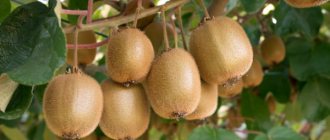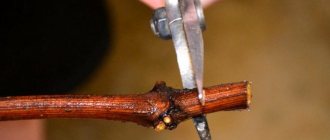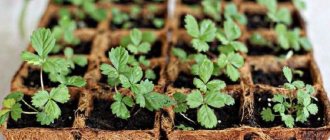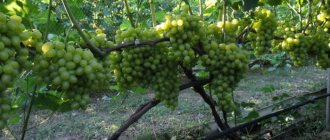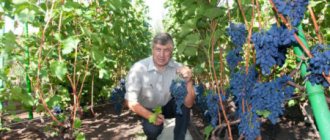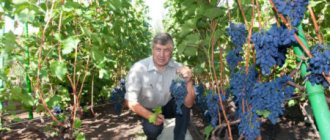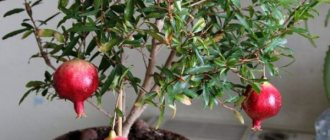It’s easy to grow a grape seedling yourself; you don’t need any special conditions or equipment for this. Even a beginning winegrower can fully provide himself with planting material during the warm season without any financial investment.
Growing seedlings with your own hands is convenient and profitable in all respects:
- Varietal chibouks cost a mere trifle compared to ready-made planting material.
- Rooting cuttings allows you to obtain a viable seedling in early summer, while cuttings in open ground only in September. In fact, in 1 season the cutting manages to go through a 2-year cycle and begins to bear fruit 1 season earlier.
- The winegrower is not tied to seasonal supplies of planting material to the market - he has the opportunity to independently and completely free of charge grow any number of seedlings of excellent quality.
- After autumn pruning of the vines, you can get so many shanks that they are enough even for the production of seedlings on an industrial scale.
The useful ability to grow planting material with your own hands will always be useful for repairing, expanding or starting a new vineyard.
A little theory that an ordinary summer resident cannot do without
All the rules for cutting vines for harvesting chibouks have a scientific basis. Without a clear understanding of the structure of the vine, cutting cuttings turns into a set of sequential monotonous actions to fulfill strict and completely incomprehensible requirements.
All operations for harvesting grape cuttings will seem simple and understandable if you understand the structure of the vine segment. Nodes and internodes - the entire grape vine consists of them.
The easiest way is with internodes . Their main purpose: transit of nutrients and water, by analogy with human blood vessels. The outer cover (bark) protects the wood from damage and moisture loss. Under the bark is the cambium , a thin layer of tissue responsible for regeneration processes. If we continue to draw analogies with the human body, cambium is an analogue of stem cells, which, under certain conditions, give rise to any organ. In the case of grape propagation, it is the cambium cells that develop into the root system of the seedling.
For the successful transformation of cambial tissues, a supply of nutrients and moisture is required. in the core , which support vital processes during winter storage and feed growth processes during rooting.
The second mandatory component responsible for metabolic processes is water. The distribution of water reserves in the vine (and the cut cuttings) depends on the nodes, which can be simply described as a regular membrane.
There are 2 types of nodes (see picture):
- The core channel is blocked to a large extent - the outflow of nutrients is significantly slowed down. Most nodes on vines are of this type. They are responsible for the outflow of nutrients at the end of the season from the leaves to the roots and sleeves.
- The internode forms an almost blind membrane, which maximally retains the flow of water and nutrients. Type 2 knots on the vine are easy to find - just find a knot with a tendril .
The most promising units for preparing pipes can be easily determined by eye:
- evaluate the difference in the thickness of the vine and the diameter of the node and select a section of the vine according to the principle “the thicker the node, the stronger the growth bud”;
- For the lower (heel, root) part of the cutting, select nodes with remnants of a tendril, i.e., with a developed internal partition.
After such a “lyrical digression,” there should be much fewer questions about the rules for cutting cuttings.
Why take grape cuttings in the fall?
If the spring (until mid-April) germination of cuttings is consistent with the natural calendar, then rooting in the winter, starting in November, has a different goal, namely: an annual gain in the growing season of the seedling, and, as a prize, a possible signal bunch of grapes the very next year.
Winter forcing of seedlings has one important advantage over spring germination. It is believed that from November to early January, the growth buds of the vine go into hibernation, i.e. in their cells, for the purpose of self-preservation, the rate of metabolic processes sharply decreases. But in the root tissue, the mechanism of natural dormancy is not provided by nature, therefore, under certain conditions (about them below), the roots can germinate before the buds awaken - and this is precisely the goal that the winegrower pursues, regardless of the timing of germination.
However, wanting to benefit from nature for the whole year, the gardener must be prepared to spend additional money on full lighting during several winter months. In any case, to grow on a windowsill or in a grow box, the cuttings must first be germinated.
Comparison of grape cutting methods: choose simple and reliable
Gardeners of the Central region are accustomed to autumn planting, which invariably shows good results in the survival of fruit seedlings in the month of September. Currant cuttings are traditionally planted in greenhouse “schools” in late autumn in order to obtain a strong young bush during the season.
Unfortunately, the benefits of autumn rooting do not apply to grape seedlings. The result does not live up to expectations - the yield suitable for further cultivation is unpredictable (no more than 20%).
Reason 1
The cutting must go through a period of rest - the tissues responsible for the development of roots and fruit vines must ripen within 3-4 months. It only seems that the cuttings “sleep” in winter. In fact, unhurried metabolic processes are taking place: the rudiments of all plant organs are developing. Without this phase it is impossible to obtain a strong seedling.
You can try to hurry up nature and root green grape cuttings in the summer. Be prepared to spray daily, monitor temperature and light conditions. The slightest miscalculation and violation of the regime leads to rot or drying of plants. Even if everything worked out, the cutting took root and began to grow, it is strictly forbidden to plant it in open ground.
Reason 2
The vines of an adult bush easily tolerate frosts of -15...20 degrees (some varieties - up to 35). The root system dies at -10...12 degrees. Rooted cuttings are planted to a depth of 20...30 cm. The young seedling is doomed - its roots freeze out, the plant will not survive until spring.
Interesting fact
Winegrowers of the southern regions, despite the relatively warm autumn and winter, prefer to root chibuki in the spring at home in cups or a little later - in shkolkas. The experience of many generations confirms that such chibouks easily form roots and shoots, and in the summer they are completely ready for planting in a permanent place.
The only requirement: high-quality cuttings are needed - cut on time, properly stored and prepared for rooting. Autumn planting of cuttings in a schoolhouse does not give guaranteed results even in the Southern region
Grape propagation by grafting
Like most fruit trees, grapes can be grafted. Carrying out grafting is no more difficult than, for example, in the case of an apple tree, but not all varieties are compatible, and success in each specific case is not guaranteed. Therefore, it is advisable to study the literature before the operation, look for which adult bushes can be grafted with one or another variety. If you haven’t found such information, all you can do is experiment.
Grafting grapes is as common as grafting fruit trees.
In the case of grapes, all known grafting methods are used (splitting, copulation, budding, etc.), but the number of options is even greater. They are grafted with both last year's cuttings and those cut from the current year's shoots. Both in the standard or last year's escape, and in the current year's escape. Therefore, the appropriate terminology is used: “black to black”, “black to green”, etc. There is even a desktop, winter vaccination.
So, for example, “black to black” grafting is performed in the spring, when active growing season has not yet begun. The scion is made from cuttings cut in the fall and stored in the cold. For such grafting, the buds on the cuttings should be slightly swollen. It is performed using copulation methods. Cuttings that are suitable in thickness to the shoot of the rootstock are selected, soaked, oblique cuts are made on the cuttings and rootstock, they are connected and the grafting site is firmly tied. When new shoots for cuttings grow to 25–30 cm, they are pinched.
In the case of “black to green” grafting, last year’s cuttings with emerging buds are grafted onto young, powerful green shoots of the current year. This type of grafting is usually performed using the “split” method. It is possible throughout the growing season, as long as it is possible to preserve lignified cuttings harvested in the fall in the cellar.
It is also possible to graft into the trunk of an old bush when the top layer of soil is dug up in early spring; The cuttings are grafted underground, usually using the “split” method. It is done at a depth of about 15 cm. The cutting is completely buried with earth.
Harvesting cuttings
To cut cuttings, you need to prepare a sharpened pruner.
In the case of harvesting chibouks from bushes of different varieties, be sure to prepare waterproof tags in advance.
When to take cuttings
Grape chubuks are harvested only after the vines have ripened: late in the fall - during the period from leaf fall to frost. By this time, the cuttings have accumulated the maximum amount of winter reserves: photosynthesis products, various sugars.
Geographically, the timing of autumn pruning varies greatly. In the Central region this may be the end of October, in the south - November or even the first days of December.
It is much easier to navigate not by calendar dates, but by weather signs that exactly correspond to the biorhythms of plants.
Helpful advice
It is better to be late with pruning grapes than to rush and trim the bushes too early.
On time - at the first signs of winter:
- steady weather with night frosts;
- daytime temperatures are just above zero degrees;
- thin ice in the morning along the edge of the reservoir, etc.
For pruning vines and harvesting shanks, you should choose a dry, clear day.
How to properly cut vines into cuttings
Even in the summer, the best bushes for propagation should be noted: in terms of yield, presentation of the bunch, size and taste of the berries. It is best to harvest the stems in parallel with pruning, immediately setting aside promising sections of the vine separately.
Unripe tops are cut off immediately.
- A mature vine is easy to determine literally by touch : in addition to the characteristic crunching sound when bending, the mature area seems warm compared to the cool, unripe top of the vine.
- For cuttings, vines from 8 to 12 mm in diameter are suitable : those that are too thin take root worse and produce weak, sickly seedlings; thick “fatty” shoots are unsuitable for another reason: their underdeveloped “eyes” practically do not form fruitful branches.
- For the lower (heel) part of the cutting, choose nodes with a tendril - such cuttings take root much better.
The lower 1/3 of the vine is considered the best for cutting pipes. This area always has time to ripen well and contains the maximum amount of nutrients. Ideally, it is advisable to put this entire segment for storage.
On a large farm with a large vineyard, it is justified to leave such long cuttings for winter storage. They are buried in a trench. At home, especially in a city apartment, you have to shorten the vine sections to a reasonable size :
3-4 buds + at least 1/2 the length of the internode.
Even when cutting 2 varieties of grapes, the cuttings should be labeled. The shade of the bark can change during storage, and all sorts of “memory nodules” after 3-4 months only cause bewilderment.
Preparation of pipes - methods and timing
Winegrowers will confirm that at least 90% of all vines have to be removed from the bush during pruning and summer green operations. From all these trimmings you can always select a sufficient number of cuttings for rooting.
- During autumn pruning, lignified cuttings are cut. To do this, select fully mature annual vines without damage to the outer cover by diseases or pests. The top 1/3 of the vine is unsuitable for cuttings. For winter storage, cut stems with 3-4 internodes.
- Green cuttings of spring harvesting are obtained by breaking off unnecessary grape shoots. The thin tops of the vine are unsuitable for propagation. The diameter of the green shoot must be at least 8 mm.
Lignified cuttings harvested in autumn contain a significant supply of nutrients - if the technology is followed, their rooting rate approaches 100%.
What determines the preparation of cuttings for storage?
Already on the day of pruning, you should deal with the delayed cuttings. Left outdoors, they immediately begin to lose moisture, so valuable for planned rooting.
The optimal way to store harvested vines is in a trench, where they will definitely not dry out or rot. In the Central region, during winter, at a depth of 60...70 cm, the temperature remains around 0 degrees.
For colder regions, rotting organic matter is placed on top of the trench to prevent soil freezing. This method is good for everyone, except for one thing - until the soil thaws, it is impossible to remove the cuttings.
So it turns out that the method of storing grape cuttings depends on how soon they will be needed in the new season.
- For the needs of a large vineyard, a large number of cuttings are prepared, which, when warmer weather arrives, are planted in a schoolyard. Such cuttings are most often stored buried in a trench, where they definitely will not dry out. It is quite enough to disinfect the vine sections with vitriol.
- Owners of small vineyards often store material for propagating grapes in the basement or cellar. Some of the cuttings wait until it gets warmer, others are taken out in February and rooted to produce a full-fledged seedling by the beginning of summer.
- Summer residents usually harvest cuttings in small quantities and store them in the refrigerator or cellar. It is important for gardeners to be able to monitor the condition of the vine during storage and take appropriate measures if necessary. To obtain seedlings early, rooting begins in winter, in February.
Let's look at how to properly prepare cut vines for storage at home in more detail.
The need for germination
To propagate grape bushes, they use seed germination, rooting layering or cuttings, and planting ready-made seedlings. The seed growing method is used very rarely. It takes a long time to get the finished plant. In this case, many young plants die or do not retain varietal characteristics. Ready-made seedlings are good because they allow you to immediately get a ready-made young plant. But buying seedlings always results in significant costs.
Most often, for home breeding of the varieties you like, cuttings or rooting of grapes by layering are used. In this case, the use of a particular option is determined by the weather and climatic conditions of the region where the plants are grown. If warm weather sets in early and is not limited to one summer month, rooting of cuttings is used. In all other cases, growing by cuttings or stems is recommended.
Important! Cuttings are the preferred method of growing grapes in northern regions with short summers, few sunny days and a high risk of return frosts.
Advantages of growing grapevines by cuttings:
- For cutting cuttings, a young fruit-bearing vine is used.
- Any variety is suitable for cuttings.
- To obtain high-quality planting material, chopped planting material is prepared in a certain way. Rooting is carried out so that the cuttings have given roots by the time they are transplanted to a permanent site.
- Transplanting planting material adapted to the conditions of the site is faster than rooting layering.
Before planting in a place of permanent growth, the harvested chibouks must be germinated. Only then can you get a healthy, strong bush that will take root well in a short time, produce foliage and withstand diseases.
Preparing pipes for storage
All the troubles that can happen to cuttings during winter storage are associated with excess or lack of moisture:
- if there is a deficiency, they will dry out;
- if there is an excess, they will rot or die from a fungal disease.
When stored in an accessible area (cellar, basement, refrigerator), the lack of moisture can be easily corrected. For example, compensate by spraying. But remember! That waterlogging is much more dangerous for cuttings, because... this threatens the development of rot and fungal diseases, which are much more difficult to cope with. Diseased cuttings will be of no use.
Online and printed publications strongly recommend “soaking” harvested vines in cold water for 2 days. This necessary precaution is intended to restore the water balance of cuttings that have already dried out for a day or two. Freshly cut vines do not require additional soaking before storing.
“It’s easier to prevent a disease” - a common phrase about prevention is ideal for plant diseases. Treatment with 3% copper sulfate will help cope with dormant fungal spores.
- Copper sulfate does not dissolve well in cold water, so to prepare an effective solution, you need to pour 30 g of copper sulfate (2 tablespoons) with 1 liter of hot water and wait until the solution cools to room temperature.
- It is enough to immerse the cuttings in the solution for 15-20 seconds, this will be enough to prevent such a dangerous fungal disease as mildew.
- Long cuttings are treated sequentially on both sides if it is not possible to disinfect in one go.
After such treatment, the pipes should be left in the open air to wait for the remaining water from the disinfectant solution to evaporate.
, waxing of cuttings is also used . The ends of the pipes are momentarily dipped into paraffin melted in a steam bath with the addition of garden varnish: for 1 candle, add about 1 teaspoon of varnish, which gives the mass plasticity.
A thin layer of melt instantly forms a protective waterproof film. You can use both white and colored paraffin for decorative candles.
Attention
Only completely dry cuttings can be waxed. Random moisture or plant juice from an undried cut is a breeding ground for the proliferation of microorganisms. Checking the condition of the cuttings once every 2 weeks during the winter is a sufficient measure to control humidity.
Growing on the basis of green chibouks
Chubuk is the same cutting, that is, part of an annual green or ripened shoot of a grapevine.
In industrial viticulture, green stems are used as a reserve for propagating scarce varieties. They are harvested not in the fall (like ripened ones), but in the spring. Non-lignified cuttings from the lower or middle part of the shoot are suitable for propagation. They are cut in such a way that on each one-eyed chibouk there is a bud, a leaf and a stepson on the upper cut, and half a node on the lower cut. After this, the cuttings are immediately ready for rooting in the greenhouse.
For planting, drainage is poured onto the bottom of the boxes, and wet sand is placed on top in a layer of 4-5 cm. After planting the chibouks, the boxes are covered with film. The temperature in the greenhouse is maintained at 24-27°C, sand humidity is 90-95%. Overheating and wilting of the leaves should not be allowed. After rooting, the cuttings are transplanted into a schoolhouse.
Storing cuttings
Depending on the planned method of obtaining seedlings and the real capabilities of the vineyard owner, the optimal method of storing the chubuks is chosen. Let us dwell on the recommendations for amateur gardeners. There is no point in digging trenches to store several dozen chibouks harvested for repair or expansion of the vineyard.
There are simple and affordable methods that allow you to periodically check the condition of the vine, and start growing seedlings on the eve of spring.
Basement, cellar
A dark, cool place without temperature changes is ideal for wintering chibouks.
For the basement/cellar there are 2 simple ways to store cuttings
Gardeners practice the “in the sand” method in 2 variants:
- In a spacious box, the cuttings are placed horizontally and sprinkled in layers with a large amount of slightly damp sand. It turns out to be an analogue of storage in a trench.
- Most often, bulky dishes (buckets, pots) are filled with raw sand and the pipes are stuck in with the heel down.
In a refrigerator
The lack of a cellar is not a reason to refuse to harvest cuttings for the winter. Even in a small kitchen refrigerator there is always room for cuttings.
The optimal temperature for storing pipes is +2...+6 degrees, on the bottom shelf or vegetable compartment of the refrigerator.
Depending on the capacity of the refrigerator, gardeners practice various options for packaging cuttings - in polyethylene, PET bottles, etc.
Any of these methods requires mandatory monitoring of the condition of the cuttings. You need to check your bookmark at least 2 times a month. Both excess moisture and drying out are detrimental to cuttings.
Planting care
Young plants, especially during the rooting period, require careful care, which includes watering, mulching, fertilizing and other measures.
- After planting, the cuttings need to be watered abundantly - at least three times a week, after heating the water in the sun. After some time, watering is reduced to twice every seven days. To prevent moisture from evaporating, the soil can be mulched with peat or sawdust. At the end of summer, to stimulate the maturation of new shoots, you can completely stop watering.
Young grapes require frequent watering
- Immediately after watering, you need to loosen the top layer of soil, without getting close to the young roots.
- It is imperative to remove weeds so that they do not draw nutrients from the soil.
- At the beginning of summer (June), the plantings should be fed using a solution of 10 grams of potassium salt, 10 grams of urea, 15 grams of superphosphate, diluted in 10 liters of water. The next application of fertilizers is required in early August, for which phosphates and potassium salt are used.
- Pruning must be done regularly, otherwise the shoots will grow too large and the berries will be small. In the first year, the roots that have come to the surface, as well as immature shoots, are removed. Next spring you need to cut off the frozen and damaged parts, pinch the tops of the shoots and tie them to the supports. The first serious pruning is done when the lateral shoots reach a length of 15 cm, leaving no more than two shoots on each cutting.
Grown bushes need timely pruning
As a rule, grape cuttings take root well and begin to grow actively, after which they bear fruit. Problems are possible with improper storage of planting material, violation of rooting rules, improper use of growth stimulants and fertilizers (excessive amounts of nitrogen).
Propagation by cuttings is a simple and affordable way to grow grapes on your own plot, and if you follow the rules of planting care, the bushes will delight you with a rich harvest.
Rooting cuttings
The chibuki remain in the cellar, basement or refrigerator at least until the New Year. It is simply not advisable to take them out ahead of time and root them: there is more hassle, the result is worse.
The end of winter - it's time to get out the pipes
Growing seedlings itself has a specific goal: to provide a time advantage compared to seedlings from an open-air school. This is how gardeners in the southern regions (Kuban) reason. For other winegrowers, early rooting of chubuks at home is the only real way to get a strong bush during the season that can survive the winter.
The absence of a period of biological rest affects plants as negatively as lack of sleep affects humans. 2-3 months of winter sleep is a necessary development phase that increases the plant’s immunity. It is better not to disturb the cuttings cut in November until mid-January, since metabolic processes do not stop during sleep, and the rudiments of growth shoots are formed in the eyes.
The second objective reason why chibuki should not be germinated before the New Year is the length of daylight hours. During the first stages of rooting, sunlight is not necessary, because only heat matters for the formation of root primordia. Lighting will be needed only after 1.5 months for the development of escape from the bud. Just in March, daylight hours begin to noticeably increase and the need for artificial additional illumination of the seedling disappears.
Preparing for germination
It is not advisable to place the stems for rooting directly from the cellar or refrigerator; first you need to start the metabolic processes: prepare the vines for rooting. This is a responsible process, errors in which affect not only the quality, but also the quantity of seedlings obtained.
Final cutting of the vine into planting cuttings
1. Using sharp pruning shears, cut the vines into cuttings:
We make the lower straight cut at a distance of 1/2 cm from the bud directly below the node with traces of the tendril. It is at this node that there is a diaphragm, the presence of which guarantees good rooting.
We make the upper oblique cut 2-3 cm above the top node . The cutting plane must be chosen in such a way that water can flow away from the side of the peephole.
- In order not to distract the vitality of the cutting from germinating roots, experienced winegrowers recommend plucking the eye from the lower node . The rule is applicable only for cuttings with two or more internodes; cuttings with one node do not need such an operation.
- Furrowing. A traditional gardening technique is designed to activate the cambium. Shallow cuts and scratches applied to 1⁄3-¼ of the lower part of the cutting trigger regenerative processes and cambium cells turn into root rudiments.
Cuttings treated with paraffin are cut and furrowed in the same way; the procedure is no different. Water will flow through the updated cut. The remains of the protective layer do not interfere with the rooting process at all.
Soaking is the final stage of preparation
The cuttings prepared in this way are soaked in cold water for a day or two: it is better to take rainwater or settled tap water. To stimulate root formation, experienced gardeners recommend using bee honey in the amount of 1 tablespoon per bucket of water. It contains all the necessary microelements and enzymes. The bucket with the cuttings is left in a cool place for no more than 2 days; if soaked for longer, the cuttings may suffocate.
After a day or two, the cuttings are completely ready for germination; weak ones can be additionally treated with root formation stimulants (Kornevin or heteroauxin according to the instructions).
Cuttings according to Radchevsky
A very simple and yet effective method of rooting cuttings at home was proposed by the famous winegrower Pyotr Radchevsky. All you need are cuttings and a regular glass jar:
- Cut the vines (as mentioned above) and soak in cold water with the addition of one spoon of honey per bucket.
- Pour 2-3 cm of water into a glass jar and install the prepared cuttings. Thermal insulation must be organized - a stand (cardboard, board, polystyrene), it is necessary so that cold air does not cool the water in the jar.
- For storage, it is advisable to choose a south-facing window. If there is a lack of natural light in gloomy weather, it is advisable to install additional lighting. Under the influence of rays, on day 10-15 the eyes on the cuttings will wake up and sprout.
- The root primordia become visible only 1 week after the formation of shoots. This is fine. The cuttings feed on water and their own supply of nutrients.
The tiny roots are very fragile and, when grown, do not tolerate transplantation well. For rooting in the ground, barely noticeable roots (no more than 5 mm in length) are enough.
How to root grapes in peat
All preliminary work with cuttings is no different from germination in water. Therefore, we saturated the cuttings with water, treated them with any rooting agent, then took peat tablets, poured boiling water over them, waited until they swelled and cooled. Should become these barrels
We stuck the cuttings into the tablets, then took a bag, for example, white ones in rolls for food products, immersed the tablet with the cutting in it and tied it with tape at the point where the cutting entered the peat. The bag is needed so that the peat does not dry out; there is enough moisture in it for the cutting to take root. If the cutting is thick, a shoot develops from the bud, but the roots are not visible and you observe that the peat is already dry, then take a syringe, pierce the bag and slightly moisten the peat. Don’t pour too much, grapes don’t like swamps, it’s better to underwater than overwater.
Growing seedlings
Cuttings with barely noticeable roots up to 5 mm should be planted in the ground; cups or cut PET bottles will do.
Planting cuttings
It is better to prepare containers and soil for germinating cuttings in advance, so that when the roots appear, the stems can be planted for rooting immediately. The soil requirements for rooting cuttings must be considered as a separate item to avoid common mistakes.
The soil
When growing seedlings (or seedlings from seeds), the main task is to create conditions for good root growth. The development of the root system determines the rapid survival of the seedling in a permanent place and its subsequent growth. With the best of intentions, gardeners provide the most fertilized soil and thereby do a disservice: with an excess of nutrients, the roots almost do not grow, since they have no need to penetrate the volume of soil in search of everything they need.
To germinate cuttings, it is best to use loose soil with a moderate amount of organic matter , in equal parts:
- sand,
- garden soil,
- mature humus or compost.
The mixture is prepared at optimal humidity. Use the rule: soil, squeezed in your hand, forms a lump and does not stain your palm. This is the state of the soil that should be adhered to and should not be over-moistened under any circumstances.
You should be prepared for the fact that the roots of even chibouks of the same variety will not hatch at the same time.
Planting chibouks
Disposable plastic cups with a capacity of 0.5 liters look neat and attractive, but their volume is not sufficient for the development of the root system of a seedling. To plant grape cuttings for rooting, larger containers are required - approximately 1 liter.
Cut PET water bottles are well suited for this purpose.
- It is convenient to use 1.5 liter bottles without a neck; their capacity is just over 1 liter.
- Stagnation of water is strictly contraindicated, so drainage holes are required.
- To avoid stagnation of water, drainage is laid at the bottom. You can use a layer of expanded clay, pebbles, crushed stone, etc.
- To prevent the top layer of soil from clogging the drainage channels, a piece of agrofibre is laid on top of the expanded clay.
- Pour 2-3 cm of prepared soil.
- Install the cutting and gradually carefully fill the container with loose soil, shaking a little to compact it.
As a result, the cutting should be buried 10-12 cm into the soil. It is watered and placed in a well-lit place.
Propagation of grapes by digging in vines
Many shrubs are propagated by layering, that is, by digging branches (shoots) in one way or another. This option is also possible in the case of grapes, and if successful, you can get several new grape plants in one summer. In this way, they usually try to propagate difficult-to-root varieties. Since future seedlings essentially feed from the roots of the mother bush, they develop well and form a powerful root system of their own.
Digging in a woody shoot
This is usually done in early spring, before the growing season begins. Choose conveniently located powerful shoots from last year. In the right place, they dig a fairly deep ditch, up to half a meter, extending from the bush to the place where they are going to bury the vine. Naturally, it should not be deep directly next to the bush, so as not to damage the roots. Well-fertilized soil with humus and superphosphate is poured into the ditch, at the very bottom, and a shoot is laid. You need to bend it carefully so as not to break it, and you can attach it to the bottom of the ditch with a piece of bent thick wire or simply press it down with a heavy stone.
It’s not difficult to spread out the vine, but you have to do it carefully so as not to break it
Where there will be a new bush, the vine is carefully bent, taken out and tied to a stake. All eyes located from the mother bush up to the point of this bend are removed. Many specialists tie it tightly with wire at the very beginning of the shoot, near the mother bush, to make it easier to separate a new plant later in the year. The ditch is gradually filled with soil and watered well. As a rule, within a year good roots grow in the buried area, and the following spring the new plant is separated from the mother plant.
Digging in green shoots
In the summer, in June or July, you can dig in the powerfully grown green shoots of the current year. They do this in a similar way, bringing to the surface the tip of the shoot with two or three leaves. If the shoot is very long, it can be buried with a “sinusoid”, bringing it to the surface several times. All parts remaining underground must be secured to the bottom of the ditch with pins.
If you do not allow the soil to dry out in the summer, for well-rooted varieties you can even get several new bushes this way by next spring.
Performing “Chinese” layering
Chinese are called layering, which is performed by completely laying a lignified shoot into the ground. This is done in the case of the most poorly rooted varieties. For installation in early spring, choose a long shoot located at the very base of the bush. Dig it all the way into a ditch no more than 20 cm deep. Also into fertilized soil, also pinning it to the bottom of the ditch. But the ditch is not completely filled up: the layer of soil above the vine is first made no more than 5 cm. And only as new shoots emerge from the buds and grow, soil is gradually added to the ditch. Keep the trap moist at all times.
Usually new shoots grow from each buried bud; In the fall, carefully dig up the vine and cut it into several new plants. However, for this to happen, you have to sacrifice part of the harvest and reduce the load on the mother bush. In the summer it is necessary to break out not only the extra bunches, but also all the stepsons and some of the young shoots.
Video: laying green vines in the ground
Strong seedlings from cuttings - what you need to know
Even at home it is possible to obtain viable seedlings. Oddly enough, it will be necessary to minimize the manifestations of excessive “care”. It is enough to create optimal conditions for the manifestation of the plant’s potential:
- Roots require warmth to grow: a window sill above a radiator is ideal.
- The cool air from the cold glass helps inhibit the growth of the green shoots of the vine. This is necessary to maintain a balance between the development of underground and aboveground parts.
- Do not overuse watering ! Water only when the soil dries out. It is best to use bottom watering through a tray, so the grapes will take exactly as much water as they need.
- 2 weeks after planting for rooting, seedlings should be fed with complex water-soluble fertilizer such as Master or Kemira according to the instructions (1 teaspoon per 2 liters of water).
Such fertilizing is practiced at intervals of 2 weeks, until the seedlings are planted in a permanent place in open ground.
Planting in a temporary place
After the roots grow up to 0.5-2 cm long, they need to be transplanted to a temporary place, otherwise, when planted in open ground, the roots will become tangled and can easily be injured. To do this, you need to take large plastic bottles or buckets and make several holes at the bottom to allow moisture to drain out. The soil mixture can be composed of leaf soil, sand and humus; the optimal acidity level is 6.5-8 pH. Plant the cuttings so that the top sprouted eye is above the ground, the planting depth is about 7-10 cm.
Before planting in the ground, cuttings are temporarily planted in large containers
The seedlings should be watered very carefully so that the young roots do not rot. The temperature should be quite high (at least 15°C) - in such conditions, moisture evaporates normally and does not stagnate. The average frequency of watering is once a week, pour no more than 100 ml of water onto each bush. In cool rooms, you need to water when the plants' leaves and buds droop slightly, signaling that there is not enough moisture.
Advice! If root rot does occur, you can try to save the seedlings. To do this, the damaged part is cut down to living tissue, then put it in water, and after new roots appear on the chibouk, repeat the procedure.
Video - Growing seedlings from grape cuttings
Questions from mail
Marina, 42 years old, Tver.
Please advise the easiest way to propagate wild grapes at home. It’s so beautiful at the neighbors’ dacha both in summer and autumn.
Ornamental wild or, as it is also called, “maiden” grapes take root without any stimulants with almost 100% probability.
- In May-early June, when last year's shoot began to grow, it is cut into chibouks with 2-4 nodes. It is best to choose areas where there are already root primordia in the nodes (see photo).
- Practice has shown that it is most convenient to care for a seedling growing in an individual container. For cuttings of virgin grapes, this is a pot with a volume of 1.0-1.5 liters.
- For rooting, use a mixture of peat and sand in a ratio of 4:1.
- For cuttings without leaves, the lower node or the entire “heel” with last year’s wood is buried.
A seedling in a pot can overwinter even under snow. They are planted in a permanent place using the transshipment method in the spring, before the leaves bloom.
Nikolay, 49 years old, Tambov.
I want to grow Isabella grapes for juice, wine, and compotes. In our area it spends the winter without shelter. They advised me to cut grape cuttings in the fall and root them. Can I plant cuttings directly into the ground?
The Isabella grape variety is an unusually hardy vine that is not afraid of frosts down to 30 degrees, does not suffer from traditional fungal diseases and, what is very important, tolerates waterlogging without the formation of foci of rot. This is the only mid-latitude grape variety that can be propagated by planting directly into the ground.
You can’t count on a large yield of suitable seedlings (no more than 50%), but the lack of hassle with storage and rooting adds to the attractiveness of the autumn rooting method. When pruning the vine, you get plenty of cutting material - planting can be planned “with a reserve.”
In order for the planted chibuki to overwinter without problems, it is necessary to cover them for the winter with dry leaves, straw, spruce branches and cover them with burlap or spunbond.
Ruslan, 38 years old, Lipetsk.
I sprouted autumn grape stems every year, everything worked out well. For the first time I decided to try to root green cuttings and nothing worked, although I did everything according to the rules
The technology for rooting green (summer) and autumn woody grape stems differs significantly. The main difference is the requirements for environmental humidity:
- autumn chibouks require a minimal amount of water to form roots;
- green summer chibouks evaporate water from their entire surface and constantly require moisture, which is difficult to control in the summer.
Propagation of grapes by cuttings in summer requires constant attention. Controlling temperature and humidity in a greenhouse-school takes a lot of time; even professional winegrowers prefer to harvest chibouks in the fall.
Planting in open ground
Hardening
From mid-May to mid-June, grown seedlings are planted either in a schoolyard or in a permanent place. The upsetting procedure is preceded by a hardening process.
First, the seedlings are taken outside and left for a short time in a shaded place. Gradually, over several days, this time is increased and they are brought to a warm place only at night. Then they are planted in a permanent place and shaded, or the plant is also gradually accustomed to exposure to direct sunlight, and then planted.
Also, to carry out hardening, you can make a small greenhouse and cover the plants with oilcloth. To begin with, the ends of the greenhouse are opened for ventilation, then the oilcloth is temporarily removed altogether. Gradually increasing the time the seedlings stay in direct sunlight, they are brought to full resistance to solar light energy.
Landing
Regardless of where the seedlings will be planted - in a school or in a permanent place, the soil must first be prepared for planting.
In the school, the earth is dug up with one spade, and the bottom of the resulting hole is fertilized with humus: per 1 sq. m. use a bucket of fertilizer. Then the humus is dug up and everything is covered with discarded soil. Seedlings are planted in rows. The distance between them is about 40 cm, the distance between seedlings is 10-15 cm.
When planting in a permanent place, the area allocated for planting is filled with humus and deeply plowed. With this soil preparation, grape seedlings can be planted literally on one bayonet of a shovel.
When saving fertilizer, planting is done in grape holes. The depth and width of the holes depends on the amount of fertilizer applied and, if necessary, materials that increase soil aeration (sand, crushed stone, broken brick). When planting in such pits, the root system of seedlings should not come into direct contact with humus, as burns are possible. Therefore, the applied fertilizer is always separated from the roots by a layer of soil.
As for watering, in all cases the soil should be abundantly watered before planting and subsequently kept moist.
Care after disembarkation
In order for the seedlings to take root in a new place and enjoy good development in the future, the following manipulations are performed:
- Remove weeds. During the first 2-3 years after planting, the soil is loosened 3 times during the season - this facilitates oxygen access to the roots. The soil is mulched to retain moisture.
- Crop rotation is observed on the site - different herbs are sown.
- Plants are watered regularly and abundantly, according to weather conditions.
- Feed periodically.
- When several shoots develop, the stronger one is left, the rest are removed.
Preparation of material
For planting in the soil, the cuttings are left 20 cm long. The required cutting thickness is 0.8-1 cm. There should be from 1 to 5 buds on the vine.
The procedure for preparing material for planting is carried out in several stages:
- cutting cuttings;
- preservation;
- preparation for planting.
Much attention in preparing cuttings for planting is paid to their preservation. For planting, cuttings of grape varieties that are suitable for the conditions of the Russian climate and specific area are selected.

